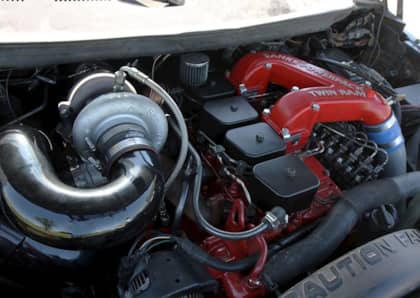The Chevrolet Astro Is The Rad 4x4 Minivan Everyone Forgot About
In the early '80s each of the Detroit Big 3 were scrambling to bring out a minivan. Chrysler was first, introducing the K-platform Voyager and Caravan that would play a major role in saving the company from bankruptcy. Ford followed soon after with the Aerostar, which grew in part from several European design studies, but it was beaten to the market by General Motors, which took a more straightforward path in creating the Chevrolet Astro.

The Chevy Astro and its GMC Safari twin provided the most traditional answer to the minivan question, looming large and imposing over its Chrysler and Ford rivals with a shape that had more in common with old school vans than its more futuristic-looking rivals. In the 15 or so years since the last model was built, the Astro has become something of a cult favorite among van fans both in America and overseas, where thousands of these stout, reliable people movers continue to pull duty for families, enthusiasts, and overlanders alike.
Conservative Looks
When the original Astro debuted in 1985, it was marketed as the 'M-van,' which Chevrolet termed 'mid' rather than 'mini' in a bid to convince buyers that the vehicle provided more space than what the competition had to offer.

While the Astro was indeed longer than the competing Plymouth Voyager, it was a game of inches, as the Chevrolet featured somewhat shorter wheelbase than its Pentastar rival (at least until extended versions of each van showed up). Still, the Chevrolet was within spitting distance of the brand's full-size vans in terms of length and width, although it did sit much lower to make for a less intimidating presence in the showroom.

Appearance-wise, the Astro and the Safari also both mimicked the upright looks of GM's full-size vans and were more square than either Ford or Chrysler's shapes. Interior space offered seating for up to eight passengers, and unlike its contemporaries it traded a rear hatch for a pair of barn doors, making it more like van-like in terms of accessing its cargo room.

The 'M-platform' that the Astro used was rear-wheel drive, and borrowed much of its running gear from existing GM vehicles: the Chevrolet Caprice full-size sedan and wagon and the Chevrolet S-10 pickup would be primary donors. With its snub-nose design, its engineers were in tough to find a spot to tuck the Astro and Safari engines. The solution was to jam them right up under the dashboard, to the point where access to the rear half of the motor was achieved through a removable panel in the vehicle's center console. The Astro offered a choice between a sub-100 horsepower, 2.5L 'Iron Duke' four-cylinder and a carbureted version of the ubiquitous 4.3-liter V6 (with fuel-injection arriving in 1986). The van was shifted by either a five-speed manual or four-speed automatic gearbox, and it could tow up to 5,000 lbs.
Generation On Pause
A series of updates would arrive for the first-generation Astro and Safari, including all-wheel drive in 1990, followed by the removal of the Iron Duke from the options sheet in 1990, and the addition of a port fuel injected version of its V6 (replacing the throttle-body unit) that would boost output to 200 horses in 1992. The manual gearbox also disappeared from the equipment list by 1993.

By 1995, the second version of the van had arrived, and GM managed to push it even further in the same styling direction as its full-size haulers. The most distinctive design cues from the new vans, were the stacked lights up front, replacing the single-square headlights from the original vans. All second-gen Astro and Safari vans also adopted the extended-length body.

It's here that Chevrolet would essentially freeze the Astro in time, with few changes made to either the passenger or cargo versions from '95 until it left the market 10 years later. Given that General Motors had introduced a new fleet of front-wheel drive minivans in 1990 (the Chevrolet Lumina/Pontiac Trans Sport/Oldsmobile Silhouette trio), it didn't make much sense to pour too much money into the Astro and Safari program.

And yet, the vans had a dedicated buyer base (with more than 3.2 million sold during their 20 years on the market) that wiping them out of showrooms didn't seem like the answer either. In fact, the Chevy and GMC minivans would outlast their front-wheel drive counterparts, which were themselves replaced by the Pontiac Montana and the Chevrolet Venture for 1997, and then by the Chevrolet Uplander after 2005.
Strong Support To This Day
Today, the Astro is prized by van fans who appreciate the taller interior and excellent cargo capability offered by its rectangular shape. Throw in the vehicle's available all-wheel drive system, and it's a van that has seen more than a little attention from both conversion companies and overland outriggers.

Both the Astro and the Safari remain inexpensive to purchase on the used market, providing you can find one that hasn't given itself over completely to the rust that plagued these models. Its 4.3 V6 is a reliable, and well-understood motor with a strong aftermarket, and there are now plenty of manufacturers out there providing suspension lifts and locking differentials for the rear axle.

Most surprising has been the van's impact outside the United States. Despite its left-hand drive build and the relative lack of brand recognition enjoyed by either Chevrolet or GMC overseas, the Astro was one of the best-selling American vehicles in Japan during the 1990s. Even today, that country's strong van culture prizes the Astro and the Safari, and it's not uncommon to see highly modified versions at the core of Japan's strong #vanlife movement.
More From Driving Line
-
Looking for a full-size 4x4 van? We've got you covered with these hardcore overland van rigs.







